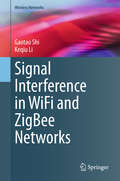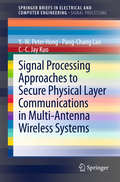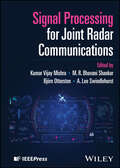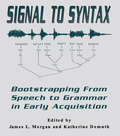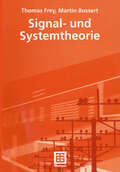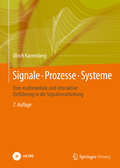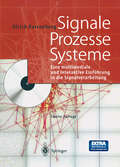- Table View
- List View
Signal and Information Processing, Networking and Computers: Proceedings of the 11th International Conference on Signal and Information Processing, Networking and Computers (ICSINC): Vol. III (Lecture Notes in Electrical Engineering #1188)
by Yue Wang Lexi Xu Jiaqi Zou Zhilei Ling Xinzhou ChengThis book collects selected papers from the 11th Conference on Signal and Information Processing, Networking and Computers held in Chengdu, China, in September 2023. The book focuses on the current works of information theory, communication system, computer science, aerospace technologies, big data, and other related technologies. People from both academia and industry of these fields can contribute and find their interests from the book.The 11th International Conference on Signal and Information Processing, Networking and Computers (ICSINC) was held in Chengdu, China, in September 2023, which focused on the key technologies and challenges of signal and information processing schemes, network application, computer theory, space technologies, big data, and other related technologies
Signal Conditioning: An Introduction to Continuous Wave Communication and Signal Processing (Signals and Communication Technology)
by Apurba Das“Signal Conditioning” is a comprehensive introduction to electronic signal processing. The book presents the mathematical basics including the implications of various transformed domain representations in signal synthesis and analysis in an understandable and lucid fashion and illustrates the theory through many applications and examples from communication systems. The ease to learn is supported by well-chosen exercises which give readers the flavor of the subject. Supplementary electronic material is available on http://extras.springer.com including MATLAB codes illuminating applications in the domain of one dimensional electrical signal processing, image processing, and speech processing. The book is an introduction for students with a basic understanding in engineering or natural sciences.
Signal Detection in Non-Gaussian Noise (Springer Texts in Electrical Engineering)
by Saleem A. KassamThis book contains a unified treatment of a class of problems of signal detection theory. This is the detection of signals in addi tive noise which is not required to have Gaussian probability den sity functions in its statistical description. For the most part the material developed here can be classified as belonging to the gen eral body of results of parametric theory. Thus the probability density functions of the observations are assumed to be known, at least to within a finite number of unknown parameters in a known functional form. Of course the focus is on noise which is not Gaussian; results for Gaussian noise in the problems treated here become special cases. The contents also form a bridge between the classical results of signal detection in Gaussian noise and those of nonparametric and robust signal detection, which are not con sidered in this book. Three canonical problems of signal detection in additive noise are covered here. These allow between them formulation of a range of specific detection problems arising in applications such as radar and sonar, binary signaling, and pattern recognition and classification. The simplest to state and perhaps the most widely studied of all is the problem of detecting a completely known deterministic signal in noise. Also considered here is the detection random non-deterministic signal in noise. Both of these situa of a tions may arise for observation processes of the low-pass type and also for processes of the band-pass type.
Signal Detection Theory
by Vyacheslav P. TuzlukovIncreasing the noise immunity of complex signal processing systems is the main problem in various areas of signal processing. At the present time there are many books and periodical articles devoted to signal detection, but many important problems remain to be solved. New approaches to complex problems allow us not only to summarize investigations, but also to improve the quality of signal detection in noise. This book is devoted to fundamental problems in the generalized approach to signal processing in noise based on a seemingly abstract idea: the introduction of an additional noise source that does not carry any information about the signal in order to improve the qualitative performance of complex signal processing systems. Theoretical and experimental studies carried out by the author lead to the conclusion that the proposed generalized approach to signal processing in noise allows us to formulate a decision-making rule based on the determi nation of the jointly sufficient statistics of the mean and variance of the likelihood function (or functional). Classical and modern signal detection theories allow us to define only the sufficient statistic of the mean of the likelihood function (or functional). The presence of additional information about the statistical characteristics of the like lihood function (or functional) leads to better-quality signal detection in comparison with the optimal signal detection algorithms of classical and modern theories.
Signal Interference in WiFi and ZigBee Networks (Wireless Networks)
by Gaotao Shi Keqiu LiThis book systematically summarizes the fundamentals of WiFi and ZigBee from different levels and provides the detailed theoretical and experimental results for signal interference between these two wireless data transmission technologies. The existing mechanisms and methods of interference mitigation, avoidance and co-existence are carefully explored. Both collaboration and cross-technology communication between WiFi and ZigBee are also introduced as key research trends. Due to the popularity of WiFi and ZigBee, which share the same ISM frequency band, interference is a common problem and addressed in a wide range of literature. This book condenses the newest research results into an approachable format. This is an essential resource for professionals and students in wireless networks as well as network engineers, designers, or planners seeking a backbone of knowledge in WiFi and ZigBee networks.
Signal Processing and Systems Theory: Selected Topics (Springer Series in Information Sciences #26)
by Charles K. Chui Guanrong Chen"Signal Processing and Systems Theory" is concerned with the study of H-optimization for digital signal processing and discrete-time control systems. The first three chapters present the basic theory and standard methods in digital filtering and systems from the frequency-domain approach, followed by a discussion of the general theory of approximation in Hardy spaces. AAK theory is introduced, first for finite-rank operators and then more generally, before being extended to the multi-input/multi-output setting. This mathematically rigorous book is self-contained and suitable for self-study. The advanced mathematical results derived here are applicable to digital control systems and digital filtering.
Signal Processing Applications Using Multidimensional Polynomial Splines (SpringerBriefs in Applied Sciences and Technology)
by Dhananjay Singh Madhusudan Singh Zaynidinov HakimjonThis book highlights new methods, algorithms and software for the digital processing and recovery of signals. In addition, it describes a new method for modeling one dimensional and multidimensional signals as successions of local polynomial splines and their spectral characteristics. It provides examples of how the proposed methods can be applied in specific cases, together with signal processing software examples in the MATLAB environment, and models of special processes in the Simulink environment. The book’s goal is to make it easier for beginners to understand the subject matter; it is intended for engineers, undergraduate and graduate students engaged in research or the evaluation and design of hardware and software for the digital processing and recovery of signals.
Signal Processing Approaches to Secure Physical Layer Communications in Multi-Antenna Wireless Systems (SpringerBriefs in Electrical and Computer Engineering)
by Y.-W. Peter Hong Pang-Chang Lan C.-C. Jay KuoThis book introduces various signal processing approaches to enhance physical layer secrecy in multi-antenna wireless systems. Wireless physical layer secrecy has attracted much attention in recent years due to the broadcast nature of the wireless medium and its inherent vulnerability to eavesdropping. While most articles on physical layer secrecy focus on the information-theoretic aspect, we focus specifically on the signal processing aspects, including beamforming and precoding techniques for data transmission and discriminatory training schemes for channel estimation. The discussions will cover cases with collocated and with distributed antennas, i.e., relays. The topics covered will be of interest to researchers in the signal processing community as well to practitioners and engineers working in this area. This book will also review recent works that apply these signal processing approaches to more advanced wireless systems, such as OFDM systems, multicell systems, cognitive radio, multihop networks etc. This will draw interest from researchers that wish to pursue the topic further in these new directions. This book is divided into three parts: (i) data transmission, (ii) channel estimation and (iii) advanced applications. Even though many works exist in the literature on these topics, the approaches and perspectives taken were largely diverse. This book provides a more organized and systematic view of these designs and to lay a solid foundation for future work in these areas. Moreover, by presenting the work from a signal processing perspective, this book will also trigger more research interest from the signal processing community and further advance the field of physical layer secrecy along the described directions. This book allows readers to gain basic understanding of works on physical layer secrecy, knowledge of how signal processing techniques can be applied to this area, and the application of these techniques in advanced wireless applications.
Signal Processing for Cognitive Radios
by Sudharman K. JayaweeraThis book examines signal processing techniques for cognitive radios. The book is divided into three parts: Part I, is an introduction to cognitive radios and presents a history of the cognitive radio (CR), and introduce their architecture, functionalities, ideal aspects, hardware platforms, and state-of-the-art developments. Dr. Jayaweera also introduces the specific type of CR that has gained the most research attention in recent years: the CR for Dynamic Spectrum Access (DSA).Part II of the book, Theoretical Foundations, guides the reader from classical to modern theories on statistical signal processing and inference. The author addresses detection and estimation theory, power spectrum estimation, classification, adaptive algorithms (machine learning), and inference and decision processes. Applications to the signal processing, inference and learning problems encountered in cognitive radios are interspersed throughout with concrete and accessible examples.Part III of the book, Signal Processing in Radios, identifies the key signal processing, inference, and learning tasks to be performed by wideband autonomous cognitive radios. The author provides signal processing solutions to each task by relating the tasks to materials covered in Part II. Specialized chapters then discuss specific signal processing algorithms required for DSA and DSS cognitive radios.
Signal Processing for Cognitive Radios
by Sudharman K. JayaweeraThis book examines signal processing techniques for cognitive radios. The book is divided into three parts: Part I, is an introduction to cognitive radios and presents a history of the cognitive radio (CR), and introduce their architecture, functionalities, ideal aspects, hardware platforms, and state-of-the-art developments. Dr. Jayaweera also introduces the specific type of CR that has gained the most research attention in recent years: the CR for Dynamic Spectrum Access (DSA).Part II of the book, Theoretical Foundations, guides the reader from classical to modern theories on statistical signal processing and inference. The author addresses detection and estimation theory, power spectrum estimation, classification, adaptive algorithms (machine learning), and inference and decision processes. Applications to the signal processing, inference and learning problems encountered in cognitive radios are interspersed throughout with concrete and accessible examples.Part III of the book, Signal Processing in Radios, identifies the key signal processing, inference, and learning tasks to be performed by wideband autonomous cognitive radios. The author provides signal processing solutions to each task by relating the tasks to materials covered in Part II. Specialized chapters then discuss specific signal processing algorithms required for DSA and DSS cognitive radios.
Signal Processing for Joint Radar Communications (IEEE Press)
by Kumar Vijay Mishra M. R. Bhavani Shankar Björn Ottersten A. Lee SwindlehurstSignal Processing for Joint Radar Communications A one-stop, comprehensive source for the latest research in joint radar communications In Signal Processing for Joint Radar Communications, four eminent electrical engineers deliver a practical and informative contribution to the diffusion of newly developed joint radar communications (JRC) tools into the sensing and communications communities. This book illustrates recent successes in applying modern signal processing theories to core problems in JRC. The book offers new results on algorithms and applications of JRC from diverse perspectives, including waveform design, physical layer processing, privacy, security, hardware prototyping, resource allocation, and sampling theory. The distinguished editors bring together contributions from more than 40 leading JRC researchers working on remote sensing, electromagnetics, optimization, signal processing, and beyond 5G wireless networks. The included resources provide an in-depth mathematical treatment of relevant signal processing tools and computational methods allowing readers to take full advantage of JRC systems. Readers will also find: Thorough introductions to fundamental limits and background on JRC theory and applications, including dual-function radar communications, cooperative JRC, distributed JRC, and passive JRCComprehensive explorations of JRC processing via waveform analyses, interference mitigation, and modeling with jamming and clutterPractical discussions of information-theoretic, optimization, and networking aspects of JRCIn-depth examinations of JRC applications in cutting-edge scenarios including automotive systems, intelligent reflecting surfaces, and secure parameter estimation Perfect for researchers and professionals in the fields of radar, signal processing, communications, information theory, networking, and electronic warfare, Signal Processing for Joint Radar Communications will also earn a place in the libraries of engineers working in the defense, aerospace, wireless communications, and automotive industries.
Signal Processing for Joint Radar Communications (IEEE Press)
by Kumar Vijay Mishra Bhavani Shankar Bjorn Ottersten A. Lee SwindlehurstSignal Processing for Joint Radar Communications A one-stop, comprehensive source for the latest research in joint radar communications In Signal Processing for Joint Radar Communications, four eminent electrical engineers deliver a practical and informative contribution to the diffusion of newly developed joint radar communications (JRC) tools into the sensing and communications communities. This book illustrates recent successes in applying modern signal processing theories to core problems in JRC. The book offers new results on algorithms and applications of JRC from diverse perspectives, including waveform design, physical layer processing, privacy, security, hardware prototyping, resource allocation, and sampling theory. The distinguished editors bring together contributions from more than 40 leading JRC researchers working on remote sensing, electromagnetics, optimization, signal processing, and beyond 5G wireless networks. The included resources provide an in-depth mathematical treatment of relevant signal processing tools and computational methods allowing readers to take full advantage of JRC systems. Readers will also find: Thorough introductions to fundamental limits and background on JRC theory and applications, including dual-function radar communications, cooperative JRC, distributed JRC, and passive JRCComprehensive explorations of JRC processing via waveform analyses, interference mitigation, and modeling with jamming and clutterPractical discussions of information-theoretic, optimization, and networking aspects of JRCIn-depth examinations of JRC applications in cutting-edge scenarios including automotive systems, intelligent reflecting surfaces, and secure parameter estimation Perfect for researchers and professionals in the fields of radar, signal processing, communications, information theory, networking, and electronic warfare, Signal Processing for Joint Radar Communications will also earn a place in the libraries of engineers working in the defense, aerospace, wireless communications, and automotive industries.
Signal Processing for Telecommunications and Multimedia (Multimedia Systems and Applications #27)
by Bahram Honary Beata J. Wysocki Tadeusz A. WysockiThe unprecedented growth in the range of multimedia services offered these days by modern telecommunication systems has been made possible only because of the advancements in signal processing technologies and algorithms. In the area of telecommunications, application of signal processing allows for new generations of systems to achieve performance close to theoretical limits, while in the area of multimedia, signal processing the underlying technology making possible realization of such applications that not so long ago were considered just a science fiction or were not even dreamed about. We all learnt to adopt those achievements very quickly, but often the research enabling their introduction takes many years and a lot of efforts. This book presents a group of invited contributions, some of which have been based on the papers presented at the International Symposium on DSP for Communication Systems held in Coolangatta on the Gold Coast, Australia, in December 2003. Part 1 of the book deals with applications of signal processing to transform what we hear or see to the form that is most suitable for transmission or storage for a future retrieval. The first three chapters in this part are devoted to processing of speech and other audio signals. The next two chapters consider image coding and compression, while the last chapter of this part describes classification of video sequences in the MPEG domain.
Signal Processing in Telecommunications: Proceedings of the 7th International Thyrrhenian Workshop on Digital Communications Viareggio, Italy, September 10 – 14, 1995 (Information Technology: Transmission, Processing and Storage)
by Ezio Biglieri Marco LuiseIt is probably an overstatement to say that the discipline of telecommunication systems is becoming an application of digital signal processing (DSP). However, there is no doubt that by the mid-I980s integrated circuit technology has advanced to such an extent that revolutionary advances in telecommunications are fostered by the introduction of new and poweiful DSP algorithms. Actually, DSP has been recently playing a major role in the development of telecommuni cations systems: to name just one of the most widespread applications where this interaction has been most effective, we may mention the use of intelligent DSP to improve the peiformance of transmission systems by allowing sophisticated algorithm to be implemented in radio transmitters and receivers for personal communications. Other areas have equally benefited by the latest advances of DSP: speech coding and synthesis, speech recognition and enhancement, radar, sonar, digital audio, and remote sensing, just to cite afew. With this in mind, when choosing the topic for the 7th Tyrrhenian Workshop on Digital Communications, whose contributions are collected in this book, we aimed at focusing on the state of the art and the perspectives of the interaction between DSP and telecommunications, two disciplines that are becoming increasingly intertwined. Although by no means exhaustive of all the applications of DSP to telecommu nications, we believe that the material presented in this book pinpoints the most interesting among them, and hence it will be considered as a useful tool for investigating this complex and highly challenging field.
Signal Processing Techniques for Communication
by K.C. RaveendranathanThe reference text discusses signal processing tools and techniques used for the design, testing, and deployment of communication systems. It further explores software simulation and modeling tools like MATLAB, GNU Octave, Mathematica, and Python for modeling, simulation, and detailed analysis leading to comprehensive insights into communication systems. The book explains topics such as source coding, pulse demodulation systems, and the principle of sampling and aliasing.This book: Discusses modern techniques including analog and digital filter design, and modulation principles including quadrature amplitude modulation, and differential phase shift keying. Covers filter design using MATLAB, system simulation using Simulink, signal processing toolbox, linear time-invariant systems, and non-linear time-variant systems. Explains important pulse keying techniques including Gaussian minimum shift keying and quadrature phase shift keying. Presents signal processing tools and techniques for communication systems design, modeling, simulation, and deployment. Illustrates topics such as software-defined radio (SDR) systems, spectrum sensing, and automated modulation sensing. The text is primarily written for senior undergraduates, graduate students, and academic researchers in the fields of electrical engineering, electronics and communication engineering, computer science, and engineering.
Signal Processing Techniques for Communication
by K.C. RaveendranathanThe reference text discusses signal processing tools and techniques used for the design, testing, and deployment of communication systems. It further explores software simulation and modeling tools like MATLAB, GNU Octave, Mathematica, and Python for modeling, simulation, and detailed analysis leading to comprehensive insights into communication systems. The book explains topics such as source coding, pulse demodulation systems, and the principle of sampling and aliasing.This book: Discusses modern techniques including analog and digital filter design, and modulation principles including quadrature amplitude modulation, and differential phase shift keying. Covers filter design using MATLAB, system simulation using Simulink, signal processing toolbox, linear time-invariant systems, and non-linear time-variant systems. Explains important pulse keying techniques including Gaussian minimum shift keying and quadrature phase shift keying. Presents signal processing tools and techniques for communication systems design, modeling, simulation, and deployment. Illustrates topics such as software-defined radio (SDR) systems, spectrum sensing, and automated modulation sensing. The text is primarily written for senior undergraduates, graduate students, and academic researchers in the fields of electrical engineering, electronics and communication engineering, computer science, and engineering.
Signal Processing Techniques for Knowledge Extraction and Information Fusion
by Dragan Obradovic Toshihisa Tanaka Danilo Mandic Martin Golz Anthony KuhThis book brings together the latest research achievements from signal processing and related disciplines, consolidating existing and proposed directions in DSP-based knowledge extraction and information fusion. The book includes contributions presenting both novel algorithms and existing applications, emphasizing on-line processing of real-world data. Readers discover applications that solve biomedical, industrial, and environmental problems.
Signal to Syntax: Bootstrapping From Speech To Grammar in Early Acquisition
by James L. Morgan Katherine DemuthIn the beginning, before there are words, or syntax, or discourse, there is speech. Speech is an infant's gateway to language. Without exposure to speech, no language--or at most only a feeble facsimile of language--develops, regardless of how rich a child's biological endowment for language learning may be. But little is given directly in speech--not words, for example, as anyone who has ever listened to fluent conversation in an unfamiliar language can attest. Rather, words and phrases, or rudimentary categories--or whatever other information is required for syntactic and semantic analyses to begin operating--must be pulled from speech through an infant's developing perceptual capacities. By the end of the first year, an infant can segment at least some words from fluent speech. Beyond this, how impoverished or rich an infant's representations of input may be remains largely unknown. Clearly, in the debate over determinants of early language acquisition, the input speech stream has too often been offhandedly dismissed as a potential source of information.This volume brings together internationally-known scholars from a range of disciplines--linguistics, psychology, cognitive and computer science, and acoustics --who share common interests in how speech, in its phonological, prosodic, distributional, and statistical properties, may encode information useful for early language learning, and how such information may be deciphered by very young children. These scholars offer a spectrum of viewpoints on the possibility that aspects of speech may provide bootstraps for language learning; contribute important, state-of-the-art findings across a variety of relevant domains; and illuminate critical directions for future inquiry. The publication of this volume represents a significant step in renewing the bonds between two fields that have long been sundered--speech perception and language acquisition.
Signal to Syntax: Bootstrapping From Speech To Grammar in Early Acquisition
by James L. Morgan Katherine DemuthIn the beginning, before there are words, or syntax, or discourse, there is speech. Speech is an infant's gateway to language. Without exposure to speech, no language--or at most only a feeble facsimile of language--develops, regardless of how rich a child's biological endowment for language learning may be. But little is given directly in speech--not words, for example, as anyone who has ever listened to fluent conversation in an unfamiliar language can attest. Rather, words and phrases, or rudimentary categories--or whatever other information is required for syntactic and semantic analyses to begin operating--must be pulled from speech through an infant's developing perceptual capacities. By the end of the first year, an infant can segment at least some words from fluent speech. Beyond this, how impoverished or rich an infant's representations of input may be remains largely unknown. Clearly, in the debate over determinants of early language acquisition, the input speech stream has too often been offhandedly dismissed as a potential source of information.This volume brings together internationally-known scholars from a range of disciplines--linguistics, psychology, cognitive and computer science, and acoustics --who share common interests in how speech, in its phonological, prosodic, distributional, and statistical properties, may encode information useful for early language learning, and how such information may be deciphered by very young children. These scholars offer a spectrum of viewpoints on the possibility that aspects of speech may provide bootstraps for language learning; contribute important, state-of-the-art findings across a variety of relevant domains; and illuminate critical directions for future inquiry. The publication of this volume represents a significant step in renewing the bonds between two fields that have long been sundered--speech perception and language acquisition.
Signal- und Systemtheorie (Informationstechnik)
by Thomas Frey Martin BossertDie Systemtheorie ist die Grundlage vieler Gebiete der Elektro- und Informationstechnik, etwa der Nachrichtentechnik, der Regelungstechnik, der digitalen Signalverarbeitung und der Hochfrequenztechnik. Sie erweist sich als ein mächtiges Werkzeug des Ingenieurs sowohl zur Analyse als auch zur Synthese von Systemen und ermöglicht ein Verständnis durch Abstraktion auf wesentliche Eigenschaften und Zusammenhänge. Dieses Lehrbuch ist eine elementare Einführung in die Signal- und Systemtheorie und ist in seiner Didaktik auf die Denk- und Vorgehensweise von Ingenieuren ausgerichtet. Problemstellungen werden anhand einfacher Beispiele motiviert und damit die Lösungsmethoden hergeleitet. Außerdem enthält das Buch viele Zusammenfassungen, Übersichten und Tabellen in kompakter, übersichtlicher Darstellung. Dieses Lehrbuch ist daher auch gut zum Nachschlagen und als Formelsammlung geeignet.
Signal- und Systemtheorie
by Thomas Frey Martin BossertDie Systemtheorie ist die Grundlage vieler Gebiete der Elektro- und Informationstechnik, etwa der Nachrichtentechnik, der Regelungstechnik, der digitalen Signalverarbeitung und der Hochfrequenztechnik. Sie erweist sich als ein mächtiges Werkzeug des Ingenieurs sowohl zur Analyse als auch zur Synthese von Systemen und ermöglicht ein Verständnis durch Abstraktion auf wesentliche Eigenschaften und Zusammenhänge. Dieses Lehrbuch ist eine elementare Einführung in die Signal- und Systemtheorie und ist in seiner Didaktik auf die Denk- und Vorgehensweise von Ingenieuren ausgerichtet. Problemstellungen werden anhand einfacher Beispiele motiviert und damit die Lösungsmethoden hergeleitet. Außerdem enthält das Buch viele Zusammenfassungen, Übersichten und Tabellen in kompakter, übersichtlicher Darstellung. Dieses Lehrbuch ist daher auch gut zum Nachschlagen und als Formelsammlung geeignet. Die 2. Auflage wurde korrigiert, aktualisiert und um eine Kurzeinführung in die Programme Matlab und Octave im Hinblick auf den Einsatz für systemtheoretische Problemstellungen ergänzt. Diese Rechnertools sind inzwischen weitverbreitet und stellen ein wichtiges Hilfsmittel des Ingenieurs dar.
Signale - Prozesse - Systeme: Eine multimediale und interaktive Einführung in die Signalverarbeitung
by Ulrich KarrenbergBuch und DVD bieten ein interaktives Lernsystem für die Visualisierung von Signalen und Prozessen sowie für die grafische Programmierung signaltechnischer Systeme. Etwa 250 vorprogrammierte Systeme und Folienentwürfe sind in das elektronische Dokument eingebettet. Mit der Software DASYLab können Applikationen entwickelt, modifiziert und optimiert werden. Die 6. Auflage bietet ein zusätzliches Kapitel zur mathematischen Modellierung, außerdem wurde sie an die aktuelle Version 11 von DASYLab angepasst und ist nun auch mit Windows 7 kompatibel.
Signale - Prozesse - Systeme: Eine multimediale und interaktive Einführung in die Signalverarbeitung
by Ulrich KarrenbergBuch und CD-ROM bilden ein Lernsystem, welches selbst erforschendes Lernen und die Visualisierung komplexer Vorgänge möglich macht. Das zugrunde liegende didaktische Konzept setzt auf die Visualisierung von Signalen und Prozessen sowie auf die grafische Programmierung signaltechnischer Systeme.
Signale - Prozesse - Systeme: Eine multimediale und interaktive Einführung in die Signalverarbeitung
by Ulrich KarrenbergBuch und CD-ROM bilden ein Lernsystem, welches selbst erforschendes Lernen und die Visualisierung komplexer Vorgänge möglich macht. Das zugrunde liegende didaktische Konzept setzt auf die Visualisierung von Signalen und Prozessen sowie auf die grafische Programmierung signaltechnischer Systeme.




